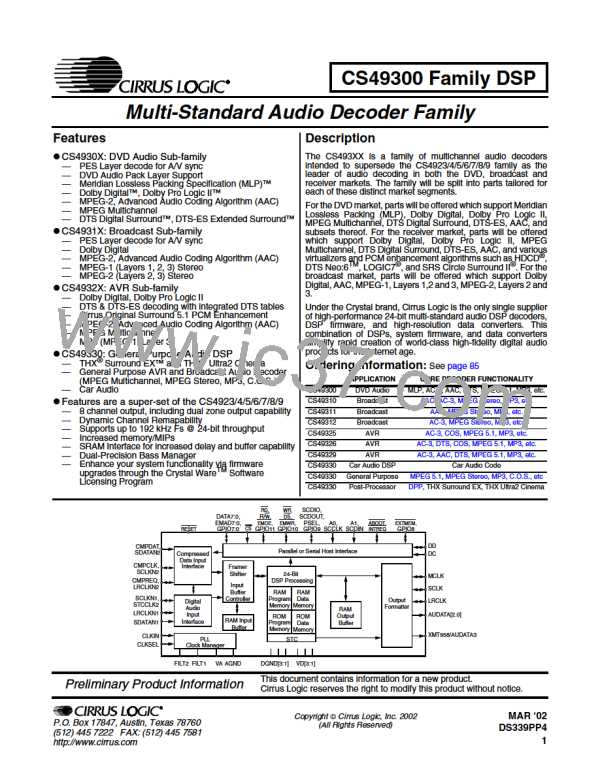CS49300 Family DSP
for the data bit D0 (SCCLK N-1), but it can go low read response message. It is guaranteed that no read
at the rising edge of SCCLK for the NACK bit
responses will begin with 0x00, which means that a
(SCCLK N) if an unsolicited message has arrived. NULL byte (0x00) detected in the OPCODE
If no unsolicited messages arrive, the INTREQ pin
will remain high after rising.
position of a read response message should be
discarded. Please see an Application Code User’s
Guide for an explanation of the OPCODE.
INTREQ behavior for SPI communication is
illustrated in Figure 21, "SPI Timing" on page 36.
When using SPI communication, the INTREQ pin
It is important that the host be aware of the
presence of NULL bytes, or the communication
will remain low until the rising edge of SCCLK for channel could become corrupted.
the data bit D1 (SCCLK N-1), but it can go low at
When case (3) occurs and the host issues a stop
the rising edge of SCCLK for data bit D0 (SCCLK
N) if an unsolicited message has arrived. If no
unsolicited messages arrive, the INTREQ pin will
remain high after rising.
condition before starting a new read cycle, the first
byte of the unsolicited message is loaded directly
into the shift register and 0x00 is never seen.
Alternatively, if case (3) occurs and the host
continues to read from the CS493XX without a
stop condition (a multiple message read), the 0x00
byte must be shifted out of the CS493XX before
the first byte of the unsolicited message can be
read.
Ideally, the host will sample INTREQ on the
falling edge of SCCLK number N-1 of the final
byte of each read response message. If INTREQ is
sampled high, the host should conclude the current
read cycle using the stop condition defined for the
communication mode chosen. The host should then
begin a new read cycle complete with the
appropriate start condition and the chip address. If
INTREQ is sampled low, the host should continue
reading the next message from the CS493XX
without ending the current read cycle.
In other words, if a system can only sample
INTREQ after an entire byte transfer the following
routine should be used if INTREQ is low after the
last byte of the message being read:
1) Read one byte
When using automated communication ports, 2) If the byte = 0x00 discard it and skip to step 3.
however, the host is often limited to sampling the
status of INTREQ after an entire byte has been
transferred. In this situation a low-high-low
transition (case 3) would be missed and the host
will see a constantly low INTREQ pin. Since the
host should read from the CS493XX until it detects
that INTREQ has gone high, this condition will be
treated as a multiple-message read (more than one
read response is provided by the CS493XX). Under
these conditions a single byte of 0x00 will be read
out before the unsolicited message.
If the byte != 0x00 then it is the OPCODE for
the next message. For this case skip to step 4.
3) Read one more byte. This is the OPCODE for
the next message.
4) Read the rest of the message as indicated in the
previous sections.
6.2. Parallel Host Communication
The parallel host communication modes of the
CS493XX provide an 8-bit interface to the DSP.
An Intel-style parallel mode and a Motorola-style
parallel mode are supported. The host interface is
implemented using four communication registers
within the CS493XX as shown in Table 5, “Parallel
Input/Output Registers,” on page 42.
The length of every read response is defined in the
user’s manual for each piece of application code.
Thus, the host should know how many bytes to
expect based on the first byte (the OPCODE) of a
DS339PP4
41

 CIRRUS [ CIRRUS LOGIC ]
CIRRUS [ CIRRUS LOGIC ]